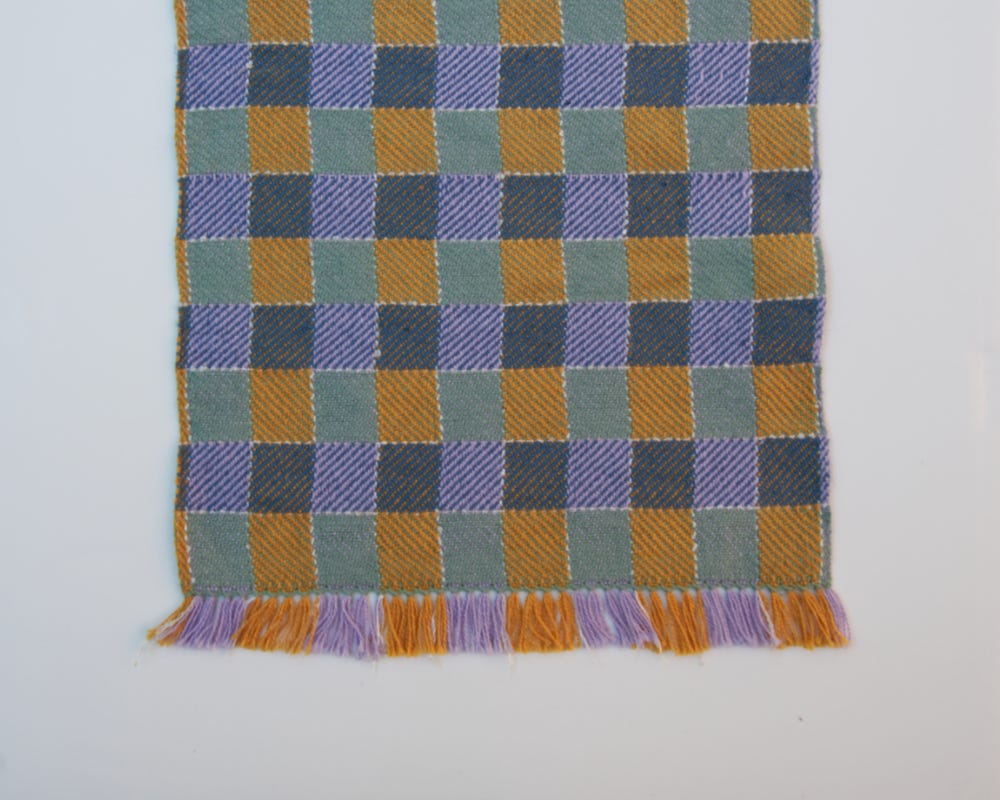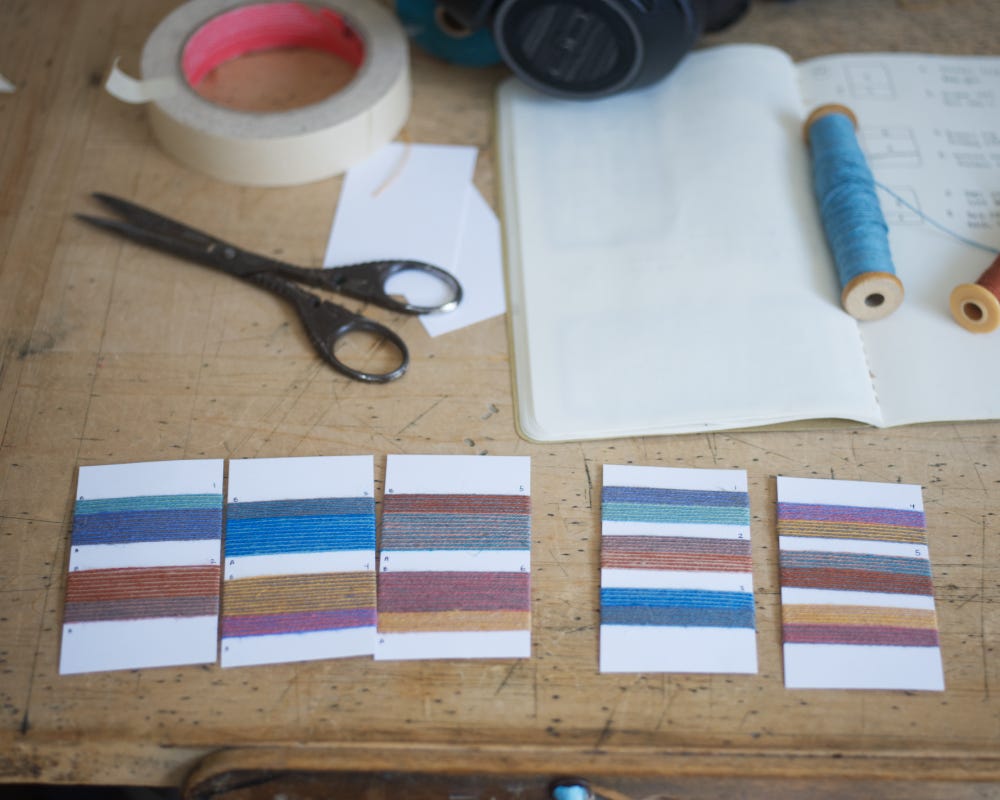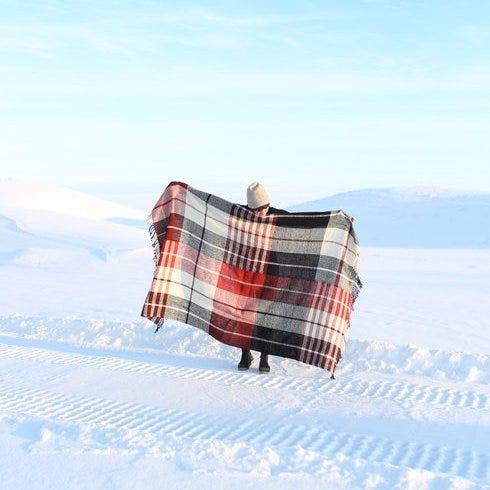March 2023
Thoughts on upholstery fabric and a doubleweave blanket.
In this newsletter you’ll find:
Weaving upholstery fabrics - thoughts and discoveries
Bauhaus Blanket from Fern’s School of Craft
Weaving for Upholstery
Last month I said I would share some more information on the final fabric I settled on to reupholster my chairs.
The original material was polyester/plastic of some variety, in 1970’s brown, and had a (glue?) coating on the back. Practically as much as aesthetically, it was time for this fabric to go, because it was shredding off some of the chairs and whatever padding there was had long gone.
Right from the start I knew I wanted to eliminate/reduce the number of petroleum-derived products in my finished chairs, so all samples were created with some composition of wool, cotton, or linen. There are many reasons I work exclusively with natural fibres, like beauty, materiality, colour, etc., but this inevitably results in questions about longevity, since there is a pervasive idea that natural = won’t last = bad.
To address this concern, I have two answers: yes, there are some things I felt made sense materially to counteract wear and tear, and secondly, I don’t care(!).
Not all natural fibres are created equally. Some of my samples used knitting wool, for example. Meant to be worn next to the skin, this wool is softer (less resistant to abrasion) and prepared in a different way than, say, carpet wool, which might be made with less soft wool that wears better, and may be spun with higher twist/grist/etc. to better withstand abrasion. So while I wanted to try this wool to get a feel for the materiality, I knew I wouldn’t actually weave with it for the finished yardage
I also tried different setts (the closeness of the individual warp and weft threads), weave structures, and yarn scales (thicker/thinner yarns) to get a sense for what I felt would work best. Sometimes I made things that I knew wouldn’t work — I just wanted to see it and feel it.
I know there is a test you can do to see how many rubs your textile can withstand before holes appear and I suppose I could have done this, but like I said — I don’t really care about longevity. If this fabric lasts another 40 years (which I imagine it will, unless I start dropping knives or spill all my dinners onto them), that will see me into my late 70s and then at that point I can weave myself new fabric or possibly I will care even less. There’s two of us and six chairs — we can rotate.
I also feel like wear is part of the learning process — and nothing simulates real wear and tear than just… living with it and using it. Will the fabric bag out or shift? Maybe. Will holes get worn into it? Perhaps! But I don’t need it to be a perfect museum piece that looks the same for its entire lifespan. I’m not going to change my home’s decor in five years and need to redo the chairs to match. If I get holes I’ll patch them. When M spills something onto them, I’ll spot clean them. I’m looking forward to seeing how the sun fades the dye and how my butt wears a curve into the padding (will it? maybe!). For me, it’s part of the never-ending learning process, or practice, of making textiles.
Okay, that long tangent has taken me somewhat away from the project itself and my final material and conceptual choices…
In the end, I used my favourite material for my chair yardage: cotton/linen. Materially, I like the way the light hits it and how it’s slightly irregular. I sett tighter than usual and made sure I beat firmly. I made a slightly larger test piece and used it as a hand towel for weeks to see how it would stand up to crumpling and movement and repeated exposure to water — which won’t happen to the chairs, fingers crossed, but still felt like a good way to work the cloth.
Conceptually, each chair has the same warp, but I’ve used different colours in the weft. The colours are all muted and fairly low contrast — I have a long-time interest in shadows and looked to the colours you see in them (and in light!) to guide my choices.
The back rest of each chair has a darker area — half of the chairs have it on the left, the other half on the right. They’re placed where you tend to put your hand to pull the chair out, sort of like a guide but also like a pre-shadow.
The seat of each chair also has two colours, and the break between them is either horizontal or vertical. The shape of the chairs is made up of squares, cubes and rectangles, and I wanted to break up the rigidity of this and reflect on the way I use and interact with these chairs: sometimes perching on different areas or sitting or kneeling.
I never really noticed the piping until I really started looking at these chairs — so it contrasts on most of them, highlighting where fabric and wood meet.
During the making of this project, someone told me that there was an illusionistic quality to these chairs and that the seat looked almost as if it was floating, wedged in between the four legs. I feel like my fabric does the opposite — instead of concealing the construction of these chairs, it shows you where the fabric is used (or could be), and highlights the meetings and connections between wood and textile, breaking the illusion somewhat. While the original fabric was a similar colour to the wood, mine is, I hope, sympathetic to the chairs while offering a contrast and change.

I have two of my edition cards leftover after the exhibition closed, so as mentioned last month, I would like to give them away. For subscribers who receive this in their inbox, please respond to the email to let me know if you would like one, and I’ll pick two names randomly.
Bauhaus Blanket
High on my personal to-weave list is a wool blanket for our bed. Canadian weaver Fern Facette of Fern’s School of Craft in Edmonton, Alberta has just published a beautiful doubleweave pattern, the Bauhaus Blanket. For the past few years she has offered this blanket as an in-person course and I’ve always loved seeing what people make in the class, it seems like a project that really gets people going! Fern has an amazing line up of workshops for weaving, punch needle, willow basket weaving and more — I only wish we lived closer so I could take some of them.
The Bauhaus Blanket PDF weaving pattern can be purchased on her website here.
March has been busy — more to share next month!
Amanda










Those chairs are amazing! Your work never ceases to inspire me. I would love a an exhibition card! ❤️
I would love one of the exhibition cards, so please put me on the list for tye draw. Thank you so much for sharing your process and material considerations for this project!